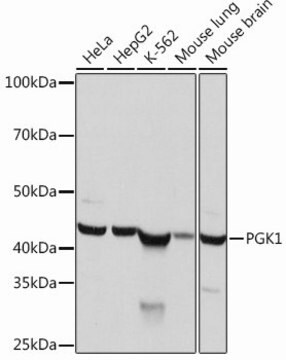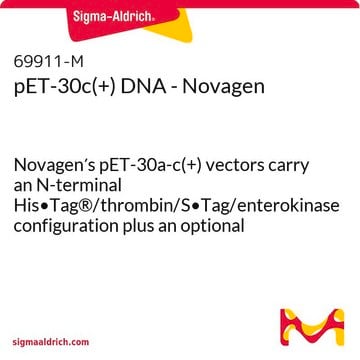E8283
pFLAG-CTS™ Expression Vector
Bacterial vector for periplasmic expression of C-terminal FLAG fusion proteins
Sign Into View Organizational & Contract Pricing
All Photos(2)
About This Item
UNSPSC Code:
12352200
Recommended Products
tag
FLAG® tagged
grade
for molecular biology
form
buffered aqueous solution
shipped in
dry ice
storage temp.
−20°C
General description
The pFLAG-CTS™ Expression Vector is a 5.3 kb E. coli expression vector used for cytoplasmic expression of a properly inserted open reading frame as a C-terminal FLAG® fusion protein. The FLAG epitope is a small, hydrophilic 8 amino acid tag (DYKDDDDK) that provides for sensitive detection and high quality purification using ANTI-FLAG products.
C-terminal FLAG fusion proteins may be purified using Monoclonal ANTI-FLAG M2, Catalog Number F3165, and ANTI-FLAG M2 Affinity Gel, Catalog Number A2220.
The pFLAG-CTS-BAP Control Plasmid is a 6.7 kb E. coli plasmid used for efficient and controlled periplasmic expression of C-terminal FLAG-BAP fusion protein.
Vector Maps and Sequences
C-terminal FLAG fusion proteins may be purified using Monoclonal ANTI-FLAG M2, Catalog Number F3165, and ANTI-FLAG M2 Affinity Gel, Catalog Number A2220.
The pFLAG-CTS-BAP Control Plasmid is a 6.7 kb E. coli plasmid used for efficient and controlled periplasmic expression of C-terminal FLAG-BAP fusion protein.
Vector Maps and Sequences
Application
The pFLAG-CTS™ Expression Vector is suitable for cloning and expression of C-terminal FLAG® fusion proteins in E. coli.
Components
- pFLAG-CTS™ Expression Vector 10 μg (E5269) is supplied as 0.5 mg/ml in 10 mM Tris-HCl (pH 8.0) with 1 mM EDTA.
- pFLAG-CTS™-BAP Control Plasmid 1 μg (P7707) is supplied as 0.5 mg/ml in 10 mM Tris-HCl (pH 8.0) with 1 mM EDTA.
Principle
The promoter-regulatory region of the strong tac promoter (a hybrid of the trp and lac promoters from E.coli) drives transcription of ORF-FLAG fusion constructs. Control of transcription is regulated by the presence of the lacO sequences and inclusion of the lac repressor gene (lacI) on the plasmid.
Legal Information
FLAG is a registered trademark of Merck KGaA, Darmstadt, Germany
pFLAG-CTS is a trademark of Sigma-Aldrich Co. LLC
Storage Class Code
12 - Non Combustible Liquids
WGK
WGK 3
Flash Point(F)
Not applicable
Flash Point(C)
Not applicable
Personal Protective Equipment
dust mask type N95 (US), Eyeshields, Gloves
Choose from one of the most recent versions:
Certificates of Analysis (COA)
Lot/Batch Number
It looks like we've run into a problem, but you can still download Certificates of Analysis from our Documents section.
If you need assistance, please contact Customer Support.
Already Own This Product?
Find documentation for the products that you have recently purchased in the Document Library.
Montarop Yamabhai et al.
Journal of biotechnology, 133(1), 50-57 (2007-10-24)
Bacillus spp. are Gram-positive bacteria that secrete a large number of extracellular proteins of industrial relevance. In this report, three Bacillus extracellular hydrolytic enzymes, i.e., alpha-amylase, mannanase and chitinase, were cloned and over-expressed in Gram-negative Escherichia coli. We found that
Parisa Asvadi et al.
Journal of molecular recognition : JMR, 15(5), 321-330 (2002-11-26)
In an attempt to generate recombinant anti-D reagents for possible diagnostic and therapeutic use we cloned the genes encoding the variable (V) domains of a human anti-D antibody secreted by the lymphoblastoid cell line BTSN4. A single-chain Fv (scFv) fragment
Jianzhi Zhang et al.
Proceedings of the National Academy of Sciences of the United States of America, 99(8), 5486-5491 (2002-03-28)
An improved understanding of the evolution of gene function at the molecular level may provide significant insights into the origin of biological novelty and adaptation. With the approach of ancestral protein reconstruction, we here address the question of how a
Chomphunuch Songsiriritthigul et al.
Microbial cell factories, 9, 20-20 (2010-04-13)
Mannans are one of the key polymers in hemicellulose, a major component of lignocellulose. The Mannan endo-1,4-beta-mannosidase or 1,4-beta-D-mannanase (EC 3.2.1.78), commonly named beta-mannanase, is an enzyme that can catalyze random hydrolysis of beta-1,4-mannosidic linkages in the main chain of
Jianzhi Zhang
Nature genetics, 38(7), 819-823 (2006-06-13)
Similar morphological or physiological changes occurring in multiple evolutionary lineages are not uncommon. Such parallel changes are believed to be adaptive, because a complex character is unlikely to originate more than once by chance. However, the occurrence of adaptive parallel
Related Content
Bacterial Expression Vectors: tac Promoter System
Our team of scientists has experience in all areas of research including Life Science, Material Science, Chemical Synthesis, Chromatography, Analytical and many others.
Contact Technical Service








